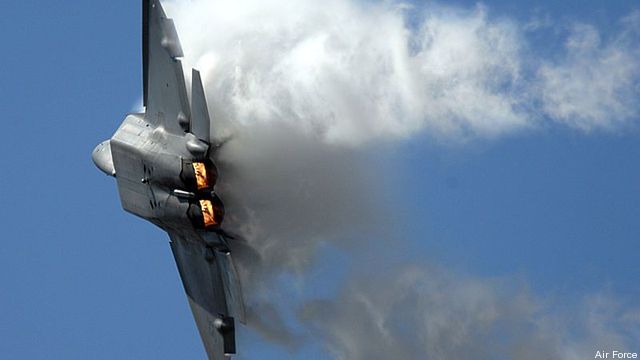Panetta Orders Air Force to Act on F-22 Safety Woes
Posted on

PENTAGON: Unhappy with the Air Force’s handling of the long-simmering problems with the oxygen system on the most expensive fighter plane in history, Defense Secretary Leon Panetta ordered restrictions on F-22 flights and told the Air Force to speed up its efforts to prevent Raptor pilots from experiencing life-threatening hypoxia in flight.
It certainly looks as if the two fighter jocks who risked their careers by airing their concerns about the safety of the Air Force’s prized F-22 super fighter on 60 Minutes got Panetta’s attention.
At a briefing here today, spokesman George Little said Panetta has ordered the Air Force to “accelerate” installation of a backup system that automatically supplies oxygen to a pilot if there is a problem with the primary system. The F-22 has a backup system but pilot’s must turn it on. When they are suffering from hypoxia, pilots find it very difficult to think and act, meaning a manual backup system may not be of much use.
The secretary also restricted Raptor flights to stay close to their airfields so pilots can land quickly should they experience problems with their oxygen system. Little and Navy Capt. John Kirby said Panetta did not set a specific limit on how far from their home field the Raptors could fly, leaving that decision to the judgment of the pilots. But they said the restriction will prevent F-22s from continuing to fly the national air defense missions from their base in Alaska. Other aircraft will have to assume those missions, they said.
Panetta also told the Air Force to report to him regularly on progress in correcting the problem with the F-22’s oxygen system, which has caused at least one fatal accident.
A longtime critic of the F-22’s costs and development problems, Winslow Wheeler, was not impressed with Panetta’s actions.
“The restrictions do not terminate the flights and continue to expose pilots to the possibility that the ‘hypoxia’ problem is not just oxygen deprivation; unknown toxins may be affecting them and ground crew. The ’60 Minute'” interview of the pilots and other information subsequently made available make it clear it may not be just an oxygen problem. Until the actual nature of the problem is uncovered, the pilots and ground crew remain at risk. The rationale for a fleet wide grounding remains clear,” Wheeler, a member of the AOL Board of Contributors and a defense expert at the Project on Government Oversight (POGO), said in an email. “Also, what is to become of the F-22s deployed to the Persian Gulf? Those pilots would appear to also be at risk and the flight restrictions do not address their situation.”
The Lockheed Martin-built Raptor is the Air Force’s pride and joy, although it has been plagued by controversy throughout its long development process and short operational experience. It is the world’s first fifth-generation fighter, boasting low radar signature — or stealth — and it can fly at supersonic speeds without using a fuel-guzzling afterburner. The Raptor is touted as able to detect and kill any adversary before the enemy knows it is near.
But, as is common with most highly advanced weapon systems, its development and early production were mired in technical problems, schedule delays and soaring cost overruns. Its escalating price forced Congress to cut production to 187, a fraction of what the Air Force wanted.
Although the Air Force says the flyaway cost of each Raptor is about $178 million, the GAO put the unit price at $412 million. The total program cost more than $79 billion.
Although it has been operational since December 2005, the Raptors have never been sent into combat and the first F-22 unit was deployed to the Persian Gulf region just this year.
The latest problem with the Raptors emerged two years ago when stories began to emerge about pilots experience symptoms of hypoxia — shortage of oxygen — while flying. Oxygen deprivation was confirmed as the cause of a fatal crash that killed Capt. Jeff Haney in Alaska in November 2010, although the Air Force accident investigation blamed the pilot for failing to activate his emergency oxygen system before losing consciousness.
Other pilots have complained about headaches and other symptoms of oxygen shortage, and the Air Force grounded the entire F-22 fleet for four months last year, but returned the Raptors to flight without having determined a cause.
The issue became toxic when two Raptor pilots with the Virginia Air National Guard — Maj. Jeremy Gordon and Capt. Josh Wilson — went on CBS-TV’s 60 Minutes show in their flight suits May 6 to say they have refused to fly the F-22 because of concerns about the safety of the fighter.
Refusing to fly an assigned aircraft can be grounds for stripping a pilot of his wings and being forced out of the service. Military officers going outside their chain of command to appear on national TV to complain about their equipment also can lead to punishment. But the air Force quickly bestowed Gordon and Wilson with whistleblower protection under pressure from members of Congress
Little and Kirby would not say that Panetta issued his orders because he was dissatisfied with the Air Force’s handling of the Raptor’s oxygen problem, saying he acted because of his concern for the safety of the pilots.
But neither of the spokesmen used the phrase – “full confidence” in the Air Force leadership, which is common in such cases.
The two spokesmen could not put a time on how long the new restrictions would stand. Kirby said the Air Force has said the testing of the automatic backup oxygen system was expected to be completed in November and installations are to start in December and go into 10 aircraft a month. The F-35 boasts an automatic oxygen backup system.
Subscribe to our newsletter
Promotions, new products and sales. Directly to your inbox.
